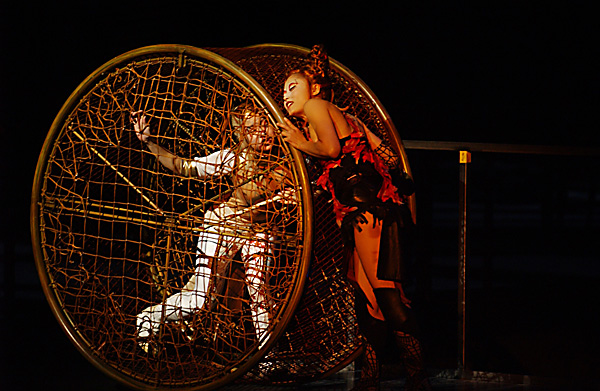|
Large and powerful are two words that come to mind regarding Cirque du Soleil’s KĂ€, which this reviewer saw in Las Vegas on July 24, 2008. Gone is the traditional stage in this 1,950-seat theater at the MGM Grand Hotel. When the show opens, the audience sees a smoking void. Think of the Grand Canyon at dusk.
NOTHING GREEN ABOUT VEGAS SHOWS
The eighty performing artists, who populate this extravaganza, work on seven independently operating platforms: the Sand Cliff Deck, the Tatami Deck, and five stage lifts. Just for an idea of scale and resource requirement, note that the Sand Cliff Deck, measuring 25X50 feet with a six-foot depth, weighs 80,000 pounds and is moved by a huge crane. Five 250 horsepower pumps and a 4,000-gallon oil reservoir power both the crane and deck. The Tatami Deck, measuring 30X30 feet, weighs 75,000 pounds and draws its power from two electric motors that operate with hydraulic brakes.
While Nevada is not known for its oil production, it has had some producing petroleum fields in the Grand Canyon but current day figures show production is dwindling since the early 1990s. Numbers aren’t much better at the Hoover Dam where the electric-generating water table is in decline due to an eight-year drought and population growth in Las Vegas.
CHOOSING A GREEN NAME
Yes, excessive use of natural resources is a stark reality in many of the popular entertainments in Las Vegas. What particularly comes to mind is “O,” another hugely successful Cirque du Soleil production. While “O” is water, KĂ€ is fire. Starting with the names of these spectacular productions, the two shows incite comparison. While “O” conjures the astonishment of the open-mouthed vowel O, that might also be written as “oh,” as well as the French word for water “eau,” KĂ€ in its monosyllabic expression, resting on the vowel of “a,” subliminally moves toward the sound of satisfaction “ah.” Think of the sounds made by an audience watching a circus show that both surprises, “oh,” and delights, “ah,” and grasp the financial psychology of naming that the masterminds of Cirque du Soleil are reaching for.
The problem is that KĂ€ doesn’t quite earn its name, which is, in ancient Egyptian religious thought, a reference to one of the five parts of the human soul. Simply put, the Ib (heart), Sheut (shadow), Ren (name), Ba (individual personality), and Ka (life force) made up a single human being. In death, the Ka left the body. The iconography of Ka with its goal post arms extending skyward tended to get misinterpreted as the human’s double or spiritual twin. This misinterpretation becomes the loose interpretation of what KĂ€ means as a title for the Cirque show. What compounds the confusion on how to relate “an invisible spiritual duplicate of the body that accompanies every human being throughout his life and into the next” (this is the official Cirque du Soleil explanation of what their title KĂ€ means) is that the story is about brother and sister twins who lose their parents and must learn to fend for themselves in an unfriendly world. However, KĂ€ is the real world and not a world filled with ghosts.
STORY VERSUS CIRCUS
Unlike “O,” KĂ€, a show relying more on martial arts and dance than acrobatic prowess, is a story-driven work, created and directed by Robert Lepage, a renowned theater and film director. Given his successful play The Far Side of the Moon (with music by Laurie Anderson) that delves into the history of the space race and paints the private story of two brothers dealing with personal loss, one would expect a deeper treatment of the KĂ€ story and its relation to Egyptian mythology. Strong use of ancient mythologies provides resounding imagery, such as that created by Robert Wilson in I la Galigo, another story of story of twins anchored in a religious landscape. This reviewer says either go deeper with the story or give the audience more circus performances.

THE GOOD STUFF
Despite these lacks, KĂ€ has many charming elements such as the agile tap dance by the hefty nursemaid to the twins, the ballet by the chief archer’s daughter after she falls in love with the brother twin, and the fascinating large-shadowed puppet display enacted by the court jester and the brother twin. What’s particularly comic is a scene where the sister twin, the nursemaid, and royal valets encounter sea creatures washed up on the beach. In the category of awe and wonder are the separate scenes featuring a man-powered flying machine, a slave cage, and an 80-foot snake in a forest where all the animals are oversized. And yes, the manipulation of the staging platforms is a jaw-dropping sight along with the performers who scale these platforms when they are upended in a perpendicular angle.
As for the music by RenĂ© DupĂ©rĂ©, some of the songs like “O Makunde” and “Pageant” provide a richness of folk tradition that marries well with the large imagery of KĂ€, while other songs, more modern in styling like “We’ve been waiting so long” tended to jar the visual experience.
This reviewer recommends the following—if you are taking young children to a show in Vegas, go to KĂ€. If you intend to go to both KĂ€ and “O,” see KĂ€ first. For “O,” sit up close; for KĂ€, move back to make sure you see the entire staging area from high to low. If you can only go to one of these two shows, make it “O.”
Photos by Cirque du Soleil
|



